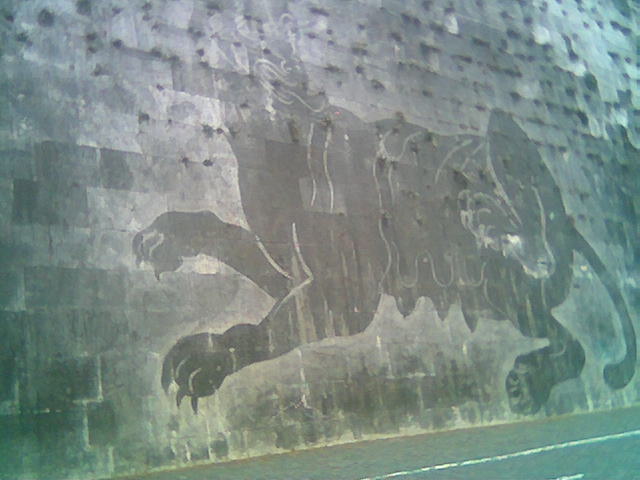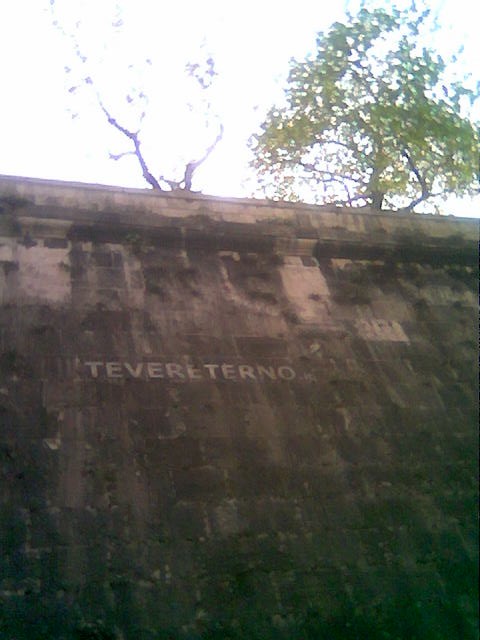IMPERFECTION? PERFECT!!!
Stains form for reasons of time, pollution, humidity, by badly unevenly applied paint, etc. Why the first reaction to embellish building is to cancel imperfections by covering the surface by an even color?First of all, nobody really knows the way walls were painted in old times.Secondly, present laws which are supposed to help conserve the cutural heritage of the past do not consider reality.What's the point of clinging to old laws and faking that they work if a whole generation of empty-headed yougsters has no intention of following them?
In many cases stains formed on old walls are so beautiful that they better be left untouched as if they were the highest art form, created by time and forces of nature. This has been done for centuries, before tourism became big business and a new fashion was born to turn ancient European cities withered textures into a cover girl's cute and powdered "perfectly preserved" face, doing everything possible to make ancient palaces look like Barbie doll houses. Preservation of antiquity with methods of a face lift?
It seems to me that intervention into time's artwork is justified only in those cases when stains are clearly stains, that is, an aesthetic formation of peeled off paint. But it has to be done carefully and with much reflection upon what one is doing.
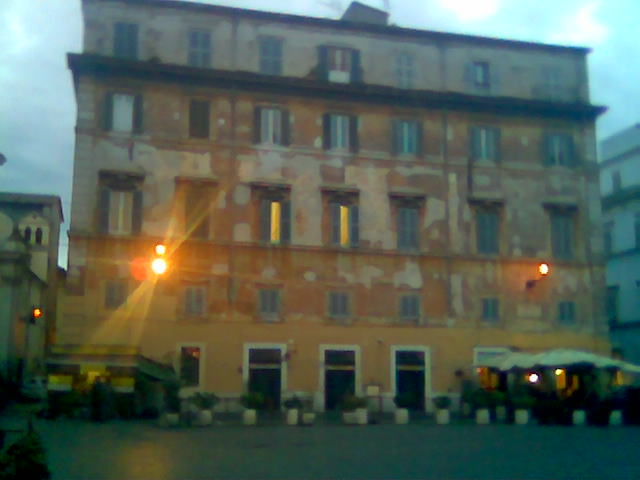
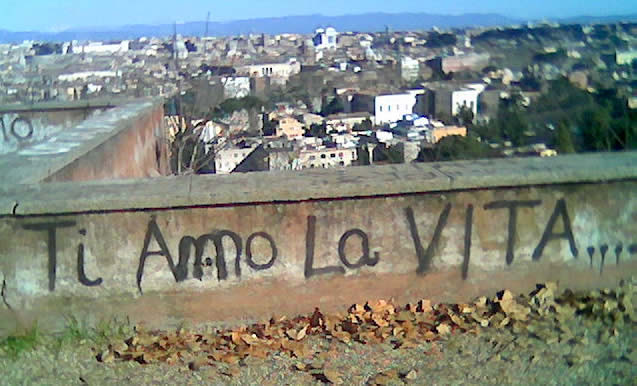
House on one of Rome's main squares which obviusly needs"retouches"."I love you,life!"is a nice thought,but why write it on an ancient wall?
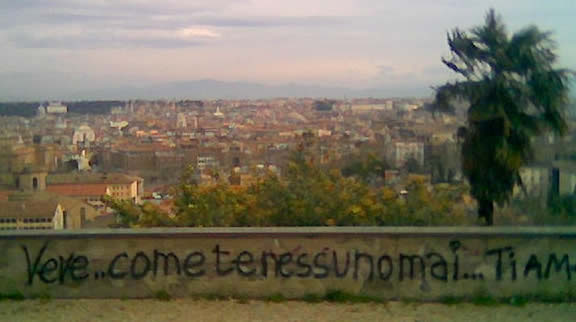
...it is prohibited to write on the walls of ancient monuments, but all the walls of the Gianicolo hill.are full of love messages...
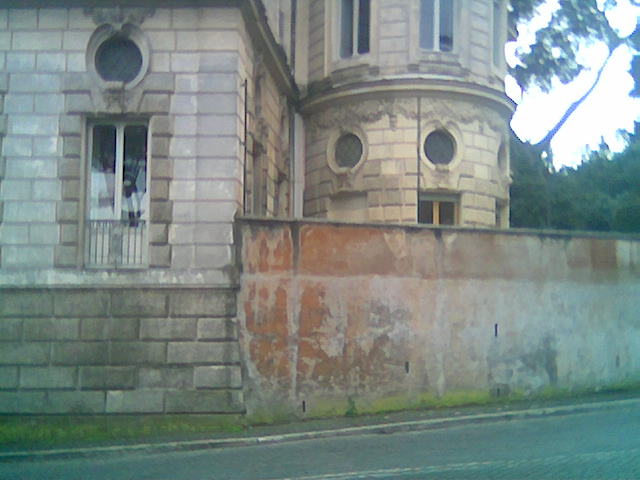

Stains created by pollution create unestetic formations of paint.........Vandals paint ancient statues into bright colours.

The walls of the American academy in Rome are "decorated" by grafitti...
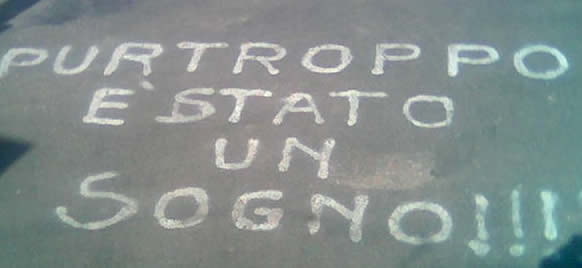
There are many ugly surfaces which in the city which could be "decorated " with love messages. Grey pedestrian pavement
with love messages written all over provokes smiles and does not damage anyone.
Time will go on to scratch surfaces and pollution will go on throwing it's veil upon city walls, not to speak about ever growing troops of city vandals who mar the walls. So why not create a new, practical and livable formula to deal with the problem, making the best with minimal effort and expense rather than fighting the destruction?
I would propose to restore antique palaces by using stains as a base for new designs. Leonardo Da Vinci recommended to his students to study stains on the walls and to use them as a jumping board for imagination.
Why not study stains not only as a source of inspiration but to preserve and incorporate them into a new design, adding as little as possible, with the maximum respect for what is already there, colorwise and shapewise. Can our civilization add so little culturally as to only repaint the surface of an ancient building with a monotonously even tone? To cancel time’s traces with careful strokes?
Why not develop creative artist‑ restorers, who will add something new to the old, but in the spirit of the initial creation? A light line, few stains close in color to the existing ones, small
additions of figurative elements here and there, can turn a stain into an artwork. Moreover, restoration work can be done without any addition of new elements, by mere subtraction, by scratching off some paint, making a mere stain turn into a desired shape.
Often today an arrogant Big Brother, the local bureaucrat, decides what is possible and what is not. So as to avoid his fines and prohibitions, one could modify stains secretly and say that they have formed by themselves. Is there a law prohibiting stains to form in the shape of a human figure or a cloud or a bird? Not as far as I know. It would be very difficult, if not impossible to prove that the stain's shape has been actually been modified. One could maintain that it just happened, because it could have happened.
I forsee a new form of art collecting: rather than buying art to be hung on the wall, the owner of a house could invite different artists to "interpret" stains which form on the facade of his home. The more stains have formed and been perfected, the bigger the collection. It might
prove to be a very good investment in the long run.
The same principle could be applied to stains that form inside due to humidity or to a leaking roof. In one Russian cottage house I saw a most original imaginary map drawn on the ceiling, where the owner had named stains as if they were islands. Rather than repairing damage, he went
along with it, creating a fantastic world for him and for his guests.
To locate my proposal on the scale of art movements, I would see this latest, "peeling off paint" proposal as a union of conceptual art and so-called "arte povera" (poor art), with the only difference that it's predecessors were confined to art galleries. What I propose not only is to be applied directly to life, but will also modify it notably. Though seemingly experimental, my proposal is very close to traditional art because the painter should be expressing sensibility
and using the techniques of masters who worked before him.
Drastic interventions which are being experimented with in Europe at the moment only show the incapacity of our civilization to generate beauty. The new fashion to illuminate antique monuments with bright colors, to project images on the facades of ancient palaces, or even worse‑grafitti "painting", the hysteric expression of rapidly growing troops of modern barbarians, which mar ancient walls, are even more damaging than water infiltrations or peeling paint.
Nor is my proposal an easy, cheap way out of a very serious problem. Only a true artist whose soul is full of poetry can stand up to the task of doing something as simple as turning a stain into a fabulous fantasy. In the hands of a mediocre artist the result will be a terrible flop. Simplicity is on the opposite side of primitivism, and just like childishness, it cannot be imitated or faked.
What I am proposing in part already exists. There is such a technique as stain painting, applied with great success by Jackson Pollock who became famous thanks to it.
I myself made a series of paintings of Flamenco dancers staining paper with colors and adding here and there figurative elements, turning a colorful hurricane into a dancing figure. If I drip something on my dress and after washing a spot remains, I embroider the spot, using it
as a suggestion for a design. The more the dress is damaged, the more whimsical becomes its decoration. The same principle can be applied to shoes as well as to other objects, such as furniture, for example.
A more futuristic proposal: for aging lady's make up, rather than covering skin imperfections with tons of powder and foundation color, why not draw around spots formed by age fantastic figures? In such a way the bites of time will turn into kisses. Again, it is to be done only in those cases when the traces left by time are really damaging the look of the person. Personally I don't see anything wrong with wrinkles and uneven skin tone‑what really matters for me is the facial
expression, but many aging ladies will disagree.
The idea of an imperfection and casual mark being transformed into part of a decoration is an aesthetic proposal, but also a practical solution for many concrete problems of today. Is it possible to repaint the whole palace each time a teenager writes on the facade "Mary I love
you!"? Is it worthwhile to repaint houses situated by the sea a few times a year? Can we afford to constantly restore buildings which are being dirtied by a polluted air? Does it make sense to cover floor and roofs with ceramic tiles in areas where earthquakes are frequent? Isn't is more intelligent to create compositions of bits of ceramics, so that after the earthquake one has to replace only a few pieces, leaving the whole as it was?
What's being proposed here is a new formula, an installation of a "mechanism" ready for being repaired problem little by little, as it arrives.If a small part of a wall is damaged, one does not have to repaint the whole building. The "spring" for this mechanism to work is great love and knowledge of the past. When one uses as canvas antique surfaces and as colors time's whimsical designs, the task is most challenging.


